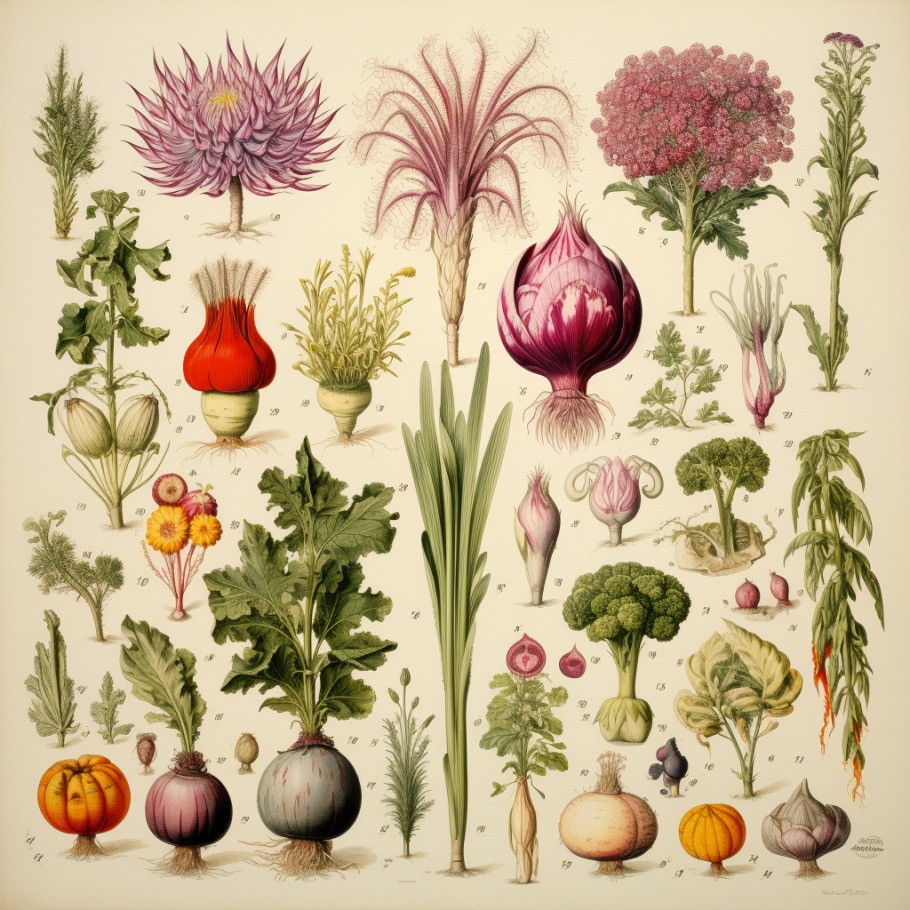Companion Planting Chart for Vegetables: A Garden in Harmony

Companion Planting Chart For Vegetables
Grab your Companion Planting Chart for Vegetables, get your hands dirty, and watch your garden flourish. Companion planting pairs vegetables that naturally boost growth, repel pests, and enrich your soil. Follow this straightforward companion planting chart for vegetables to grow healthier crops in less space—and with fewer problems. Let's cultivate harmony right in your backyard.
Cheatsheet: Veggie Companion Planting Essentials
🌱 Top Companion Pairings
- Tomatoes & Basil: Boosts flavor, deters pests.
- Carrots & Onions: Repel carrot flies, enrich soil.
- Corn, Beans & Squash ("Three Sisters"): Supports growth, maximizes yield.
- Lettuce & Radishes: Fast-growing radishes loosen soil for lettuce roots.
- Cucumber & Nasturtium: Attract predators, repel cucumber beetles.
❌ Plants to Avoid Pairing
- Beans & Alliums (garlic, onions): Stunt bean growth.
- Tomatoes & Potatoes: Vulnerable to shared diseases.
- Cabbage family & Strawberries: Inhibit each other's growth.
🐞 Natural Pest Control Companion Plants
- Marigolds: Repel aphids, nematodes.
- Dill: Attract beneficial predatory insects.
- Mint: Deters ants, flea beetles.
- Chives: Reduce aphid populations.
🛠 Tools & Products You'll Need
- Garden planner or notebook for tracking pairings.
- Plant labels for clear identification.
- Natural pest deterrents (neem oil, diatomaceous earth).
- Quality compost for nourishing soil health.
🥬 Nutritional Gains from Companion Planted Gardens
- Increased produce yield by up to 20%.
- Enhanced nutrient density and flavor of crops.
- Reduced need for chemical fertilizers and pesticides.
📋 Quick Tips for Best Results
- Rotate crops annually to maintain soil fertility.
- Space companions properly for optimal air circulation.
- Observe and document results to improve future pairings.
Why Companion Planting Rocks My Vegetable Garden
Years ago, my vegetable garden resembled a chaotic jam session—each veggie improvising wildly without any harmony. Then, one afternoon at a farmer's market, an old gardener slipped me a colorful Companion Planting Chart For Vegetables.
At first glance, it looked like some strange gardening alchemy. But after planting tomatoes with basil and seeing the yield triple, I was hooked.
Why Companion Planting Actually Works
This ancient gardening technique pairs specific veggies together, allowing plants to support each other naturally. Think of these combos like Mick and Keith or peanut butter and jelly—each better off together than alone.
Some plants repel pests, others improve soil nutrients, and a few even boost flavors. It's nature’s way of keeping balance and order in your garden patch.
Gardens practicing companion planting have been shown to reduce pest populations by up to 30%, according to the Soil Association.
Companion Planting Chart For Vegetables: The All-Star Lineup
To simplify your planting decisions, here’s an easy-to-follow list, broken down by vegetable:
- Tomatoes: Partner with basil, carrots, onions, garlic, and marigolds; each deters pests like aphids and attracts helpful pollinators.
- Cucumbers: Ideal neighbors are radishes, dill, and beans to ward off cucumber beetles.
- Peppers: Basil shields peppers from pests, while spinach makes an excellent moisture-retaining companion.
- Carrots: Onions, leeks, and rosemary confuse the carrot fly, protecting roots from infestation.
- Beans: Corn and squash (think Three Sisters planting) form a natural support system beneficial to all three.
- Lettuce: Highly compatible with carrots, radishes, and strawberries—the shallow lettuce roots leave room deeper down for carrot growth.
Plants That Shouldn't Party Together
Just as important as best friends are plants that disagree—think Lennon and McCartney post-breakup. Avoid partnering these vegetables to sidestep potential drama:
- Tomatoes & Potatoes: Both susceptible to blight, these two amplify each other's vulnerabilities.
- Onions & Beans: Onions stunt bean growth; keep them apart, and both plants thrive.
- Cabbage Family & Strawberries or Tomatoes: These vegetables often compete for essential nutrients, limiting overall productivity.
My Go-To Companion Planting Strategy
Every planting season, I sketch a quick garden layout using my trusty companion planting chart. Strategically positioning marigolds, dill, basil, and garlic means fewer pests and healthier harvests.
Last season, aphids swarmed neighboring gardens, but mine stayed virtually pest-free—nature's garden bouncers did their job beautifully.
"The difference between a good gardener and a great gardener? One manages plants; the other orchestrates relationships." —Old Gardener's Proverb
Tips For Getting Started With Companion Planting Charts
- Keep it Visible: Print and laminate your companion planting chart—I keep mine tacked near my garden tools for instant reference.
- Start Small: First-time attempt? Pick one or two combos—like tomatoes and basil—to test results.
- Record Results: Jot down pairings that boosted harvest or improved plant health—your notes become gardening gold.
Observing veggie friendships flourish season after season fills gardening with satisfying, earthy magic. Let nature teach you—and your garden sings in perfect harmony.

Want smarter plant choices? 🪴
Frequently Asked Questions About Vegetable Companion Planting
Which vegetables perform best planted side-by-side?
Champion combinations include tomatoes and basil, greatly enhancing flavor and repelling pests like aphids and hornworms. Likewise, carrots and onions complement each other, confusing carrot flies and onion maggots alike. Beans alongside corn and squash, known as the Three Sisters, symbiotically support growth and nutrient sharing. Consult a detailed companion planting chart to discover pairings that amplify your harvest.
Are there vegetable combinations to avoid planting together?
Absolutely. Certain veggies clash profoundly. Avoid planting potatoes near tomatoes: both fall victim to common diseases, and proximity invites disaster. Similarly, keep onions separated from beans, as onions stunt bean growth. A solid companion planting guide helps decipher ally from adversary in the vegetable bed.
How does companion planting naturally deter pests?
The right companion arrangements naturally weave pest control into the garden fabric. Fragrant herbs like rosemary, dill, and sage mask odors, confusing pests and attracting beneficial insects—ladybugs and lacewings—to prey on harmful ones. Nasturtiums lure aphids away from prized crops, functioning as sacrificial protectors. Strategic planting acts more potently than synthetic pesticides ever could.
Does companion planting influence flavor or growth of vegetables?
Indeed. Garden camaraderie goes beyond pest control. Pairing basil near tomatoes reportedly deepens tomato flavor. Similarly, legumes like beans fix nitrogen into the soil, fertilizing heavy feeders like corn or leafy greens. For deeper flavor and vigorous growth, carefully crafted companion planting charts detail harmonious vegetable pairings.
Should flowers be included in vegetable beds as companion plants?
Without question. Integrating flowers like marigolds, calendula, and borage into your vegetable arrangement deters pests, attracts pollinators, and enriches garden biodiversity. Marigolds repel nematodes and aphids, while borage's blooms invite bees crucial for pollination. Sophisticated vegetable gardeners rely on floral allies as fundamental companions outlined in planting charts.
A thoughtful gardener understands that growing vegetables isn't solitary—plants naturally thrive when grown together thoughtfully and intentionally. Using a companion planting chart for vegetables offers the wisdom to cultivate balanced gardens where nature is an ally, not an adversary. By pairing vegetables wisely, we encourage harmony: better yields, fewer pests, and healthier, tastier produce. Gardening with intention is about respecting connections seen and unseen—each pairing you choose contributes meaningfully to the health and vigor of your garden. Let a companion planting chart for vegetables guide you toward mindful cultivation, working with nature rather than against it, and you'll find your garden returning the favor in abundance.
Health Benefits of Companion Vegetable Planting
Enhanced Nutrient Density
Companion planting boosts vegetable nutrient absorption, enhancing vitamin and mineral density. Tomatoes paired with carrots increase carotenoid content, vital for vision and immune support.
Reduced Chemical Exposure
Companion planting naturally deters pests, decreasing reliance on synthetic pesticides. Basil grown near tomatoes repels aphids, minimizing chemical residue intake.
Increased Antioxidant Levels
Plants stressed minimally by pests produce higher antioxidant concentrations. Broccoli alongside alliums (onions, garlic) shows elevated glucosinolate content, antioxidants linked to cancer prevention.
Improved Digestive Health
- Beans paired with corn: Enhances soil nitrogen, promoting fiber-rich growth beneficial for gut microbiome.
- Cabbage planted near dill or sage: Reduces digestive irritants, easing nutrient absorption.
Reduced Heavy Metal Uptake
Mustard greens planted near leafy vegetables absorb excess lead and cadmium, protecting surrounding plants—ideal for urban gardening.
Stress Reduction and Mental Wellness
Balanced, pest-free gardens encourage mindful gardening practices, lowering blood pressure and cortisol levels, improving mental clarity.
Find out which plants will thrive in your garden!
Answer a few fun questions and get custom plant recommendations perfect for your space. Let’s grow something amazing together!

start your season





